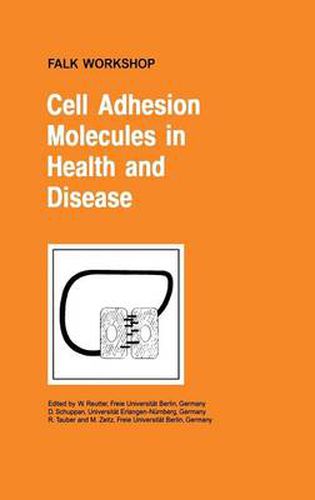Readings Newsletter
Become a Readings Member to make your shopping experience even easier.
Sign in or sign up for free!
You’re not far away from qualifying for FREE standard shipping within Australia
You’ve qualified for FREE standard shipping within Australia
The cart is loading…






This title is printed to order. This book may have been self-published. If so, we cannot guarantee the quality of the content. In the main most books will have gone through the editing process however some may not. We therefore suggest that you be aware of this before ordering this book. If in doubt check either the author or publisher’s details as we are unable to accept any returns unless they are faulty. Please contact us if you have any questions.
Cell-cell and cell-matrix interactions are of fundamental importance for the development and the maintenance of tissues and organs in multicellular organisms. Adhesive processes are mediated and controlled by an increasingly large and complex number of cell adhesion molecules that are anchored to the cell surface membrane by transmembrane domains. According to their structural and functional features, cell adhesion molecules have been classified into at least four major families: the integrins, selectins, cadherins and members of the immunoglobulin superfamily. Apart from linking cells to each other or to components of the extracellular matrix, cell adhesion molecules function also as receptors that interact via their cytoplasmic domain with numerous signalling molecules including protein kinases and phosphatases, G-proteins, or proteins of the -catenin/armadillo family. Cell adhesion molecules can activate various signalling pathways and as a consequence play a crucial role in the regulation of cell differentiation, proliferation, migration and apoptosis. During the last decade it has been recognized that acquired as well as inherited defects of cell adhesion molecules and adhesion-linked signalling molecules are the molecular basis of various types of disease including cancer, infectious and inflammatory disease, connective tissue disorders or blistering disease. This book is the proceedings of a Falk Workshop held in Berlin, Germany, on January 23-24, 2003, which brought together experts in different fields of research to stimulate the transfer of findings from basic research to clinical application. Section I focuses on cell adhesion molecules of the liver and their role in hepatocarcinogenesis and inflammatory liver disease. Section II deals with infection and fibrosis and with transforming growth factor b (TGF-b). Morphogenesis, cell migration and inflammation are the subject of Section III with a focus on the role of integrins in blood cell-endothelial interactions. In Section IV the importance of cell adhesion molecules for cancer and their role as potential targets for cancer therapy is discussed.
$9.00 standard shipping within Australia
FREE standard shipping within Australia for orders over $100.00
Express & International shipping calculated at checkout
This title is printed to order. This book may have been self-published. If so, we cannot guarantee the quality of the content. In the main most books will have gone through the editing process however some may not. We therefore suggest that you be aware of this before ordering this book. If in doubt check either the author or publisher’s details as we are unable to accept any returns unless they are faulty. Please contact us if you have any questions.
Cell-cell and cell-matrix interactions are of fundamental importance for the development and the maintenance of tissues and organs in multicellular organisms. Adhesive processes are mediated and controlled by an increasingly large and complex number of cell adhesion molecules that are anchored to the cell surface membrane by transmembrane domains. According to their structural and functional features, cell adhesion molecules have been classified into at least four major families: the integrins, selectins, cadherins and members of the immunoglobulin superfamily. Apart from linking cells to each other or to components of the extracellular matrix, cell adhesion molecules function also as receptors that interact via their cytoplasmic domain with numerous signalling molecules including protein kinases and phosphatases, G-proteins, or proteins of the -catenin/armadillo family. Cell adhesion molecules can activate various signalling pathways and as a consequence play a crucial role in the regulation of cell differentiation, proliferation, migration and apoptosis. During the last decade it has been recognized that acquired as well as inherited defects of cell adhesion molecules and adhesion-linked signalling molecules are the molecular basis of various types of disease including cancer, infectious and inflammatory disease, connective tissue disorders or blistering disease. This book is the proceedings of a Falk Workshop held in Berlin, Germany, on January 23-24, 2003, which brought together experts in different fields of research to stimulate the transfer of findings from basic research to clinical application. Section I focuses on cell adhesion molecules of the liver and their role in hepatocarcinogenesis and inflammatory liver disease. Section II deals with infection and fibrosis and with transforming growth factor b (TGF-b). Morphogenesis, cell migration and inflammation are the subject of Section III with a focus on the role of integrins in blood cell-endothelial interactions. In Section IV the importance of cell adhesion molecules for cancer and their role as potential targets for cancer therapy is discussed.